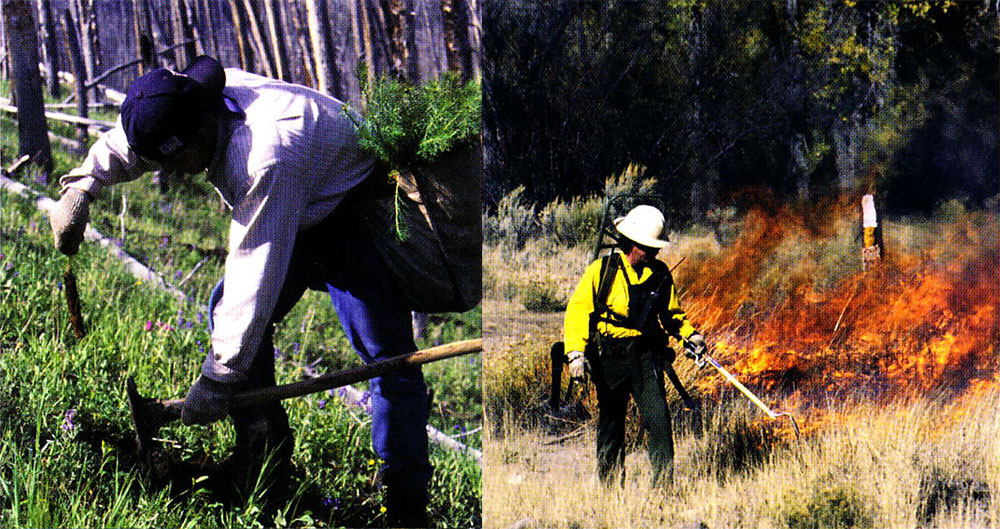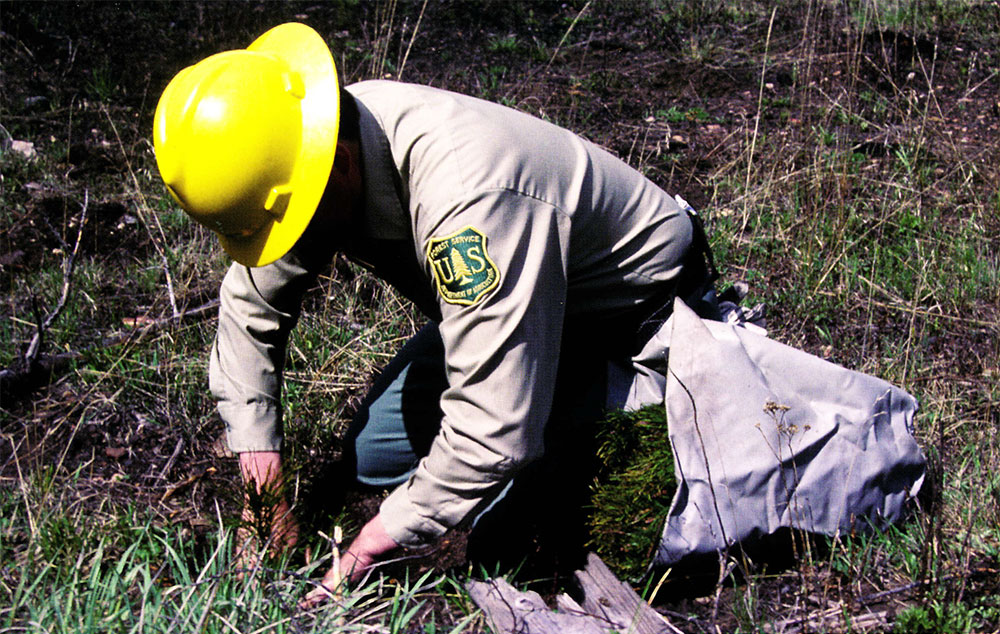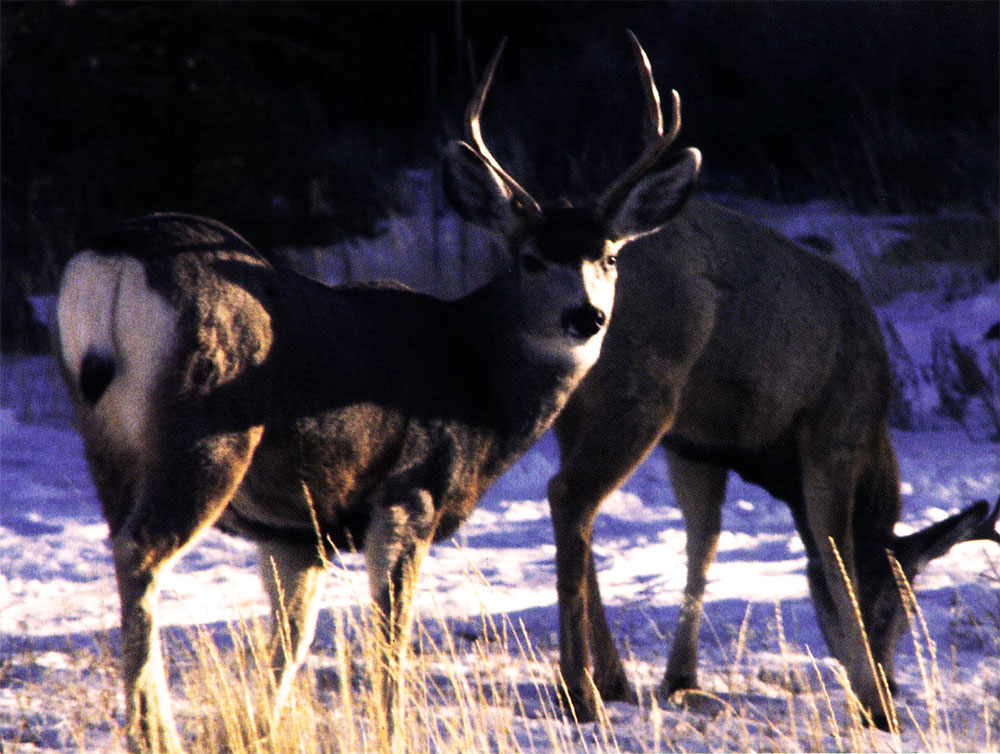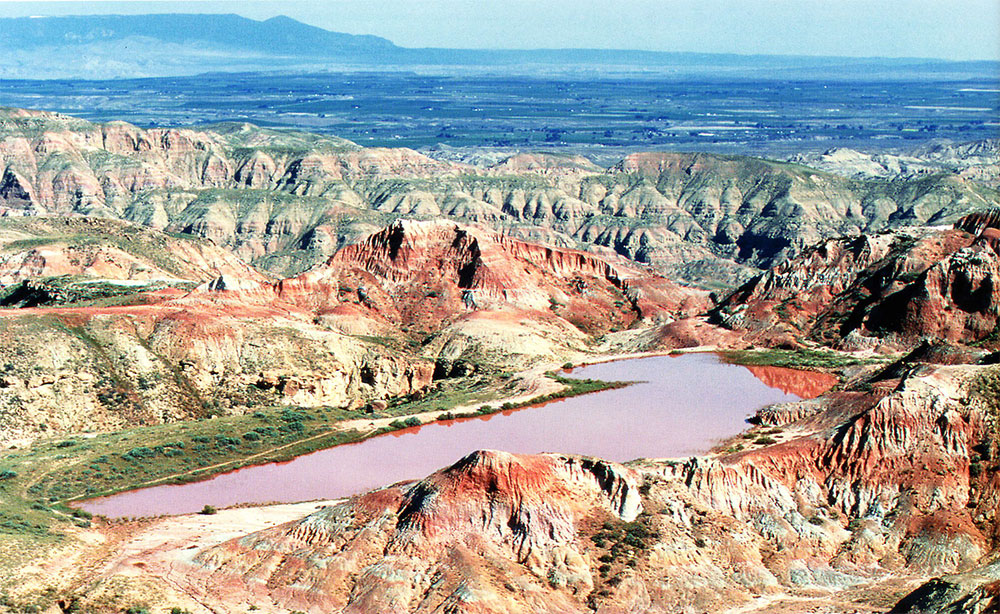 Originally published in Points West magazine
Originally published in Points West magazine
Spring 2002
The Draper Museum of Natural History: Forging the Future with Lessons from the Past
By Charles R. Preston
Willis McDonald, IV Senior Curator, Draper Natural History Museum
Ed. note: We continue our look back at the planning and opening of the Draper Natural History Museum in 2002. Click here to read Natural History? Natural Destiny!
In 1998, I was handed the challenge and opportunity of a lifetime: several lifetimes really. I was invited to help design and develop a natural history museum for a new century. Now, I’ve been around the museum world for more than 25 years. I’ve worked in several different museums as an educator, interpretive writer, collections manager, curatorial assistant, research scientist, curator, administrator, and trustee. But neither I, nor any museum professional I know, has ever been presented with a more exciting challenge. The Trustees and staff of the Buffalo Bill [Center of the West] invited me to help them shape the future, and I enthusiastically accepted. In earlier articles (Points West, Summer 1999 and Fall 1999), I have described the evolving, multipurpose role of natural history museums and the genesis of the Draper Natural History Museum. Here I provide an overview of the Draper’s inaugural exhibit galleries and place this new museum in the broader context of other museums past and present.
The dawn of the 21st century is a period of profound transition in American museums. Not long ago, most museum exhibits were designed as shrines to objects hanging on walls or tucked behind glass. The visitor’s role was to admire paintings, artifacts, or stuffed animals from afar. Audiences learned the names of objects, where the objects came from, and about the people who produced, collected, and donated them. The spaces designed to showcase objects were clean, sterile boxes that didn’t distract visitors from the material on display. Museums came to be regarded by some as mausoleums, geared more to curators and an elite group of patrons and enthusiasts than to the public at large. Museum visitation began to decline.
During the last quarter of the 20th century, a new wave of museums was created to encourage visitors to participate with exhibits. The visitor experience was focused around hands-on displays and high-tech adventures designed to compete with entertainment theme parks and video arcades. These exhibit galleries enticed visitors, especially families, back through museum doors. They did not, however, always provide a satisfying learning experience. Some critics began to view these new age museums as little more than children’s playpens.
Today’s museum audiences demand more than a passive, spectator experience and more than a titillating thrill ride. Museums have enormous potential to improve people’s lives through engaging, informative exhibits. The most successful (i.e., popular and informative) museum exhibitions I’ve seen provide both passive and active experiences, and season them with a healthy dose of relevance. Audiences are almost always interested in learning how what they’re seeing and doing in a museum relates to their own lives.

Our challenge in designing and developing exhibits and other programming for the Draper Natural History Museum was to incorporate the best ideas from the great museums of the past with an understanding of today’s audiences. The first step was to establish a relevant, overarching theme for our exhibits. That part was easy! Staff, consultants, and Draper Museum advisory board members decided early on that our research, collections, educational programming, and exhibits would revolve around the relationships binding humans and nature in the Greater Yellowstone region. This was the most logical way to integrate natural science with humanities at the Center and focus on those areas where we could most easily achieve excellence.
Yellowstone National Park and the mosaic of public and private lands surrounding it comprise one the earth’s great treasures. The core of this landscape is one of the last intact, temperate ecosystems in North America. With the controversial restoration of the gray wolf to Yellowstone, this region contains a full complement of native wildlife that was present in pre-Columbian times. But this region is not some pristine island frozen in time—it contains ranches, farms, bustling cities, and a growing human population. Humans have been a part of this landscape for at least ten thousand years, and have impacted it profoundly during the last two centuries. In turn, the climate, geology, plants, and animals of this region continue to profoundly affect human economies and cultures.
Yellowstone and Grand Teton National Parks are set aside for the enjoyment of the people and to preserve the natural environment and processes within their boundaries. What happens on the lands surrounding the national parks, however, affects the environment and processes within park boundaries. Conversely, what happens inside the parks (e.g., restoration of wolves), affects the lives and livelihood of people in surrounding communities. For this reason, the Greater Yellowstone region is a lightning rod for environmental controversy and a proving ground for new ideas related to natural resources management. Indeed, the Greater Yellowstone region has come to represent the challenges presented by our paradoxical desire to embrace nature but keep it at bay. These same challenges echo throughout the American West, and in other parts of the world, such as East Africa and the Amazon Basin. The overarching theme of the Draper Museum thus holds relevance for a global, as well as regional, audience.
Our focus on the relationships binding humans and nature is not totally new for natural history museums, but it represents a more robust and contemporary interpretation of the topic. Most traditional natural history museums present natural history factoids in wildlife or geology halls, while presenting cultural history in separate vignettes. Our approach is quite different. We are presenting humans as an integral part of nature, rather than apart from nature. The conviction that both our approach and content hold national significance was confirmed when we were awarded a major grant from the National Science Foundation to help with exhibit development and production.
Our interpretive approach is content-based, rather than object-based. Instead of positioning stories around museum objects, we decided to use museum objects and other tools to help interpret compelling concepts and stories. Early in the planning process, we decided to organize our stories around the Yellowstone setting itself. We would weave natural and cultural history together on an expedition through time and space in the Greater Yellowstone region. Our Denver-based architects (Fentress, Bradburn and Associates) and New York-based exhibit designers (DMCD, Inc.) collaborated closely to create spaces and floorplans that would work together to convey the grandeur of our geographic region and the excitement and adventure of exploring it. The Draper expedition transports visitor-explorers through three interconnected exhibit galleries: Expedition Trailhead, Mountains-to-Plains Trail, and Seasons of Discovery. Our visitor-explorers embark on their expedition through the Draper Natural History Museum from the Expedition Trailhead. The Trailhead provides a basic introduction to the mission and layout of the Draper, but will also help visitors make the transition from spectators to explorers. The Trailhead is occupied by two authentic, back-country, log cabins that you might encounter at a remote field station. One of these cabins is used as a naturalist’s study. Our resident naturalist, B.A. Ware, may or may not be present, but our visitor-explorers are invited to look around and see how and why other people from various walks of life have explored the Greater Yellowstone region. The take-home lesson for our visitor-explorers is simple: everyone can be an explorer.
The second cabin in the Expedition Trailhead is a field station classroom. The class has just left for a field trip, but it is clear that the students have been learning about the dramatic geological processes that have shaped our region. Our visitor-explorers will discover a working seismograph and be able to use computer interactive stations to explore the handiwork of glaciers, volcanoes, and other forces. People will leave the cabin with the knowledge that these forces are still at work in the Greater Yellowstone region.

From the Expedition Trailhead, visitor-explorers will begin their journey along the Mountains-to-Plains Trail. The trail winds through a grand rotunda, where visitor-explorers first encounter an alpine environment, and gradually work their way down a spiraling path through mountain forest, mountain meadow, and lowland environments. At the bottom of the grand rotunda, interpreted from an alpine overlook, is a colorful tile map of the Greater Yellowstone region. The map is thirty feet in diameter and provides a rare perspective of one of the most dramatic landscapes on Earth. The ceiling of the grand rotunda represents the magnificent embrace of the Wyoming sky.
Our visitor-explorers are immersed in each environment along the Mountains-to-Plains Trail with ambient sounds, theatrical lighting and scrims, varied carpet and wall color schemes, and scenic islands depicting slices of the Greater Yellowstone landscape. Each island features a recreation of a landscape (e.g., alpine boulder field, wolf den, grizzly feeding site, prairie dog colony, windmill and stock tank), boldly illustrated text rails and panels, and various other elements appropriate for the story. In contrast to traditional dioramas, visitors are not be separated from scenic islands by a box of cold glass. Protective cases are used to house special sculptures and cultural artifacts, but they are designed to blend with the overall presentation.
Exhibit elements include objects from the collections of each of the other museums of the Buffalo Bill Center of the West, as well as material on loan from other museums. Audiences will also encounter audio and video stations, and computer interactive stations featuring extended, virtual, tours of the environment presented. It is this rich mixture of cultural and natural artifacts, together with hands-on activities, and audio-visual experiences that sets the Draper Museum apart from traditional natural history interpretations. Our objective is to provide both contemplative and interactive experiences that facilitate individual and social learning for diverse audiences.
Near the end of the Mountains-to-Plains Trail, our visitor-explorers will encounter a passageway into Seasons of Discovery. The visitor experience is a bit different here than in the Expedition Trailhead or Mountains-to-Plains Trail. Organized around the theme of the four seasons in Yellowstone country, Seasons of Discovery is filled with even more highly interactive experiences than are found in the other two galleries. Visitors can peer through microscopes and spotting scopes, try on a bison robe, or crawl into a black bear’s den. This gallery includes an exploration station, where staff, teachers, docents, or naturalists-in-residence lead visitors on hands-on paths of discovery. There is also a campfire circle environment in Seasons of Discovery, where visitors might sometimes encounter a storyteller. If no storyteller is present, visitors can make themselves comfortable in cushioned seating areas and peruse the books, videos, and other resource materials available.
Although our approach to creating Draper exhibits was guided by trustees, staff, and consultants, it was greatly informed by our audiences. We learned much about audience interest in natural history with earlier, temporary exhibits on bison, wild horses, and John James Audubon. We also learned about the effectiveness of several cutting-edge exhibit techniques by observing visitor response to the highly innovative and successful reinstallation of the Center’s Plains Indian Museum. In addition, we contracted an outside evaluation group, Randi Korn and Associates, to test some of our ideas and exhibit design elements with prospective regional and national audiences. We believe the modifications we made in response to this exercise have greatly improved our design.
Some people view the grand opening of the Draper Natural History Museum on June 4, 2002, as the end of a long, challenging construction project. For me, it marks the beginning of an exciting new era. Modern museums are far more than exhibit galleries and collections, and the Draper Museum will become an important center for original research and educational programming regarding the relationships between nature and humans. In our proposal to the National Science Foundation, we outlined our long-term plans to promote linkages between Draper and formal education, bring natural science education programs and activities to our rural communities currently without informal science education opportunities, and improve scientific literacy among both children and adults to assist them in making informed decisions about natural science policies that have cultural implications. We will accomplish these goals through exhibit gallery presentations, on-site and outreach classroom programs, field-based tours and other programs, and a virtual explorer program through the Center website. The National Science Foundation has provided funding for a two-year natural history educator position to help us achieve these objectives.

Of course, no matter how exciting, informative, or relevant an exhibit or educational program is, it is a failure if it doesn’t attract an audience. We believe that the Center has only begun to tap our potential regional and national audiences. In addition to increased Center promotional and marketing initiatives, the Draper staff and advisory board is dedicated to aggressively promoting our new exhibits and programs through publications, public presentations, and special events.
To kick off the grand opening of the Draper, the Center is planning a week-long program of events geared toward focusing attention not only on the Draper, but on all of the museums and activities of the Center. Noted paleoanthropologist Richard Leakey will be on hand to help celebrate the Draper’s grand opening. The Draper mission is to increase the appreciation and understanding of the relationships binding humans and nature in the Greater Yellowstone region. Richard Leakey has devoted much of his life to a similar mission in East Africa. Leakey’s appearance here affirms the international importance of the Draper mission, and underscores the parallel challenges and opportunities we face in understanding and conserving the inherent values of natural treasures across the globe.
Many people, including the Draper Museum advisory board, external content and interpretive consultants, architects, building contractors, exhibit designers and fabricators, Center trustees and staff have contributed to the design, development, and installation of our exhibits. The true soul of the Draper Natural History Museum, however, is its namesake and principal benefactor, Nancy-Carroll Draper. It was her vision, her passion, and her commitment that made the Draper Natural History Museum the first new major natural history museum of the 21st century.

Post 218










